A HORSE, A HORSE, MY KINGDOM FOR A HORSE (RICHARD III), 1977
EDWIN TANNER
synthetic polymer paint on canvas
168.0 x 183.0 cm
signed and dated upper left: EDWIN TANNER, 1977
signed and dated lower right: EDWIN TANNER 1977
Realities Gallery, Melbourne (label attached verso)
Tolarno Galleries, Melbourne
National Australia Bank, acquired from the above in July 1979 (label attached verso)
Edwin Tanner, Realities Gallery, Melbourne, 30 May – 21 June 1979, cat. 16
Edwin Tanner, Murray Crescent Galleries, Canberra, 1980, cat. 26
The Seventies: Australian Paintings and Tapestries from the Collection of National Australia Bank, National Gallery of Victoria, Melbourne, 15 October – 28 November 1982
The Seventies Exhibition: Selected Paintings from the National Australia Bank Collection, MacLaurin Hall, The University of Sydney, Sydney, 6 September - 1 October 1989, cat. 33
Edwin Tanner Works 1952 – 1980, Monash University Gallery, Melbourne, 15 March – 12 May 1990, cat. 83
Penetralia: Art & Psychoanalysis in Melbourne, 1940 – 2004, Royal Melbourne Institute of Technology, Melbourne, 30 June 2004 - 7 August 2004
Edwin Tanner: Mathematical Expressionist, TarraWarra Museum of Art, Victoria, 12 May - 15 July 2018
Eagle, M., ‘Archibald prize got an artist to his peak’, The Age, 7 June 1979, p. 2
McCaughey, P., ‘Flying, cycling engineer who loves to paint’, The Age, 9 June 1979, p. 23
Lindsay, R., The Seventies: Australian Paintings and Tapestries from the Collection of National Australia Bank, The National Bank of Australasia, Melbourne, 1982, pl. 89, p. 102 (illus.)
Duncan, J., Edwin Tanner Works 1952–1980, Monash University Gallery, Melbourne, 1990, p. 28 (illus.)
Edgar, R., ‘'Visionary' artist who enraged public servants celebrated at TarraWarra’, Sydney Morning Herald, Sydney, 4 May 2018
Fitzpatrick, A., Edwin Tanner: mathematical expressionist, TarraWarra Museum of Art, Victoria, 2018, pp. 25, 26, 107 (illus.), 134
Ozymandias, 1960, oil on composition board, 84.0 x 91.0 cm, private collection
Drawing for A Horse, A Horse, My Kingdom for a Horse (Richard III), 1965, pencil on paper, 39.0 x 29.0 cm, in the collection of Robin Greer
210738.jpg

In 1967, at the age of 46, Edwin Tanner was affected by a stroke following the physical effects of a car accident suffered some years earlier, and this decline in physical health endowed his already gnomic art with existential malaise.1 Subjects of isolation, exile and existential questioning were pervasive throughout his art of the 1970s, often conveyed through recurring motifs of a bird and horse. This was, for Tanner, a sudden and brief return to representation after years of dry abstraction. Revisiting compositions first conceived more than ten years earlier, A Horse, A Horse, My Kingdom for A Horse (Richard III), 1977 is a masterpiece of Tanner’s late works, poignantly expressing the artist’s lassitude and frustrations, as always illustrated with incisive wit and literary allusion. Open-ended and philosophical, Tanner’s paintings stood apart from the mainstream currents of modern art in Australia, and despite the best efforts of critic Patrick McCaughey, is only now receiving the wider commercial and institutional appreciation he so deserved during his lifetime.
Floating in the sky above a limitless blue ocean is a disembodied horse’s head (mechanical? or concrete?) upon which sits a scarlet robin. Tanner reprises in this painting an image that first originated from a horse’s carcass he encountered on a trip to Thirroul to visit his parents in 1952. The startling encounter became a drawing – Dead Cert, 1952 (private collection), and in 1960, Ozymandias, a painting featuring the horse’s head, although now decapitated and crowned with a bird. The carrion bird is angular and menacing, appearing to be crowing atop the horses remains, which lie on the ground far from its body, just visible in the distance. Both Ozymandias and A Horse, A Horse… bear titles with clear literary references, with both written works addressing the vanity and absurdity of human wishes: the former refers to a sonnet by Percy Shelley and latter, the most famous quote from Shakespeare’s drama, Richard III. As the poetic last words of the king before he dies on the battlefield, have come to signify an expression of extreme frustration and helplessness in the face of defeat, with dire circumstances elevating a once mundane possession (a horse) to a prized tool capable of saving his life. As Ray Edgar suggested in a newspaper review in 2018: ‘for Tanner, the horse is less a traditional object of artistic veneration than a symbol of brutal truth… symbolic of empires lost (perhaps even the futility of art), it has gravitas yet simultaneously floats freely in an abstract field of blue’.2 Interestingly, the 1965 pencil sketch for A Horse, A Horse is inscribed with a line from Shelley’s Ozymandias: ‘the lone and level sands stretched far away’ and the words ‘pre-stressed concrete’, indicating the industrially engineered basis of Tanner’s horse figure.
A Horse, A Horse, My Kingdom for a Horse, was exhibited in Edwin Tanner’s last exhibition before his premature death in 1980; a retrospective exhibition of works from the previous two decades, held in Melbourne’s Realities Galleries. While Mary Eagle wrote dismissively of this painting, Patrick McCaughey immediately countered two days later in the same publication admiring the ‘handsome selection’ of artworks and noting in the paintings a ‘plangent theme… of the human as victim of his environment – tangled and snared in technology or lost in the deep blue spaces of air’.3 While his earlier paintings were decidedly humorous, even satirical, Tanner’s eccentricities are felt in the paintings of the 70s as isolating factors, keenly felt and thinly veiled amongst the abstraction of straight lines and flat expanses of paint.
A remarkable polymath with Welsh artistic sensibilities, Tanner couldn’t help but transform the painting plane into a design blueprint whose secrets were clear only to him, describing his works as ‘a wholly new start, a new raid on the subconscious’.4 Although at times his tongue-in-cheek social commentary inflamed public opinion, during his lifetime he remained largely neglected by the press and the art establishment, his works prized among artists and a small group of connoisseurs appreciative of the inventiveness of his unique artistic vision. Today his place has been rightfully re-established and solidified through further acquisitions by the National Gallery of Victoria; the Queensland Gallery of Modern Art; the Art Gallery of New South Wales; and most recently, a major retrospective exhibition held at TarraWarra Museum of Art, in which this painting was prominently featured.
1. Fitzpatrick, A., Edwin Tanner: mathematical expressionist, TarraWarra Museum of Art, Victoria, 2018, p. 129
2. Edgar, R., ‘'Visionary' artist who enraged public servants celebrated at Tarrawarra’, Sydney Morning Herald, 4 May 2018
3. McCaughey, P., ‘Flying, cycling engineer who loves to paint’, The Age, 9 June 1979, p. 23
4. The artist, cited in Horton, M., Australian Painters of the 70s, Ure Smith, Sydney, 1975, p. 57
LUCIE REEVES-SMITH
